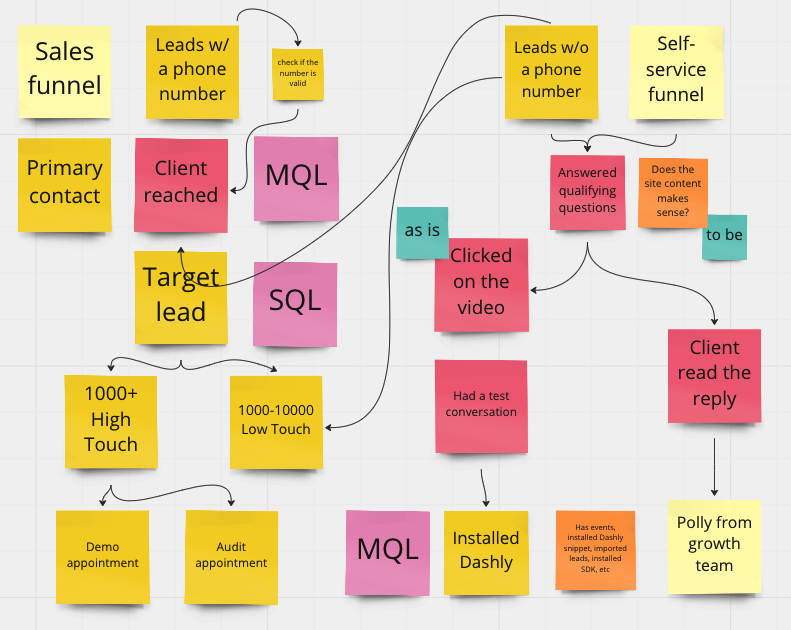4 steps as Chief Marketing Officer at a new company [Expert guide]
![4 steps as Chief Marketing Officer at a new company [Expert guide]](https://www.dashly.io/blog/wp-content/uploads/2022/10/4-steps-as-Chief-Marketing-Officer-at-a-new-company-Expert-guide-1440x634.jpg)
Well done, you’ve been appointed the head of a growth marketing team 🎉 Where to start?
When is the right time to change the existing processes?
How to locate all the bottlenecks and fix them?
Let’s find answers together with Greg, the head of marketing at Dashly. He worked in marketing management and consulting for eight years. During that time, he helped to reconstruct the business processes in over 20 companies.
As a result of the interview, we’ve collected a list of tips that will help you to get comfortable as the newly-minted head of marketing. In this article, you’ll find the first four of them, which hopefully will help you to:
- settle into a new company;
- adjust to a new role if you’ve never been in charge of a department;
- understand what things work well and what needs improvement.
When you start, expect about 3-6 months of uncertainty. It’s important to build routines that will help you hold up during difficult times.
In my case, it was yoga, morning meditation, and the gym twice a week. As for what to do during working hours, I’ll give some advice below.
Now you can read an article or check out an interview in the video 👇
1. Find out what each team in the company does and how it interacts with marketers
Learn how your marketing department and its teams function. Talk to the heads of these teams. For example, our marketing department includes the following teams:
- editors office,
- video content,
- SEO,
- production,
- product-led-growth,
- funnel team, working with paid traffic,
- analytics,
- activation team.
Get in touch with the heads of other departments:
- support/customer success,
- sales,
- product,
- development.
Pay attention to their structure and functions. Find out when and how your team interacts with others.
Build a map showing the structure of your team and its interactions with other teams. Greg has assembled his version using a mind board.
Having understood the current structure of the team, I divided all the processes into funnels and assigned a responsible for each of them. I also noted what bottlenecks there are, and what can be improved; highlighted scenarios with roles of those who request a task, and whose who perform it.
Teams typically have two types of interaction:
Executor, when the team acts as a task performer. For example, if a product team needs a new video or an article, marketing acts as a content service.
Orderer, when the team gives out a task. For example, marketing finds out that customers miss some features, and “orders” a product or development team to implement the feature.
Make sure you understand what teams expect from you as a leader in this or that interaction, where, and what kind of participation you should take.
Analyze the details of teammates’ interactions to see what it’s missing.
We have created a process for interaction within our team, its interaction with other teams. Currently, we’re iteratively improving it. For instance, we have a Slack channel for the sales and marketing team members, so we could see what hypotheses the sales department works on and what plans on changing sales materials they have.
2. Close several deals if your company has a sales team
To better understand the customer’s journey, goals, and objectives, try selling your product. For example, to friends or acquaintances whose tasks can be solved with your product. Look for potential customers wherever you go, for example, a Facebook community for local entrepreneurs or a business conference.
First, invite experts from different teams (product, development, and sales) to join your sales call with a client. They will help answer complex customer questions you are unfamiliar with.
Greg first participated in our role-playing sessions to understand how the sales process works. This is an event where people from the sales team practice in sales or act as a client from a particular business area. Specialists from other teams come to practice role-playing or to observe and listen.
As a result, participants leave their feedback on the meeting. Together they decide what was done good, wrong, and what can be improved.
Such a practice will provide you with a clearer understanding of how to build communication with clients.
3. Understand the sales funnel and analytics
After trying out the sales manager role, recreate the sales funnel yourself: the way it works now and how it should work. Discuss possible improvements with the relevant team leads. Make any corrections or additions, if necessary. Agree on what key metrics to consider.
This is a part of the customer journey made by Greg. Initially, it consisted of five steps, but the funnel was expanded after the team leads meeting:

Ensure you understand how analytics works, where and what data is located. Check the current funnel results and decide what metrics to strive for. Learn what each entity in the funnel means, and agree on how to count each metric.
We use ads managing accounts to track the visitors flow and our expenses. Using Dashly tools, we track custom data and website visitors behavior. We pass the data about the events to Google Analytics. The data from the forms is transferred via Dashly’s integration to CRM, where the sales team tracks the deals.
As a result in:
- Dashly you can check all the lead data and visited pages;
- CRM you can see the deal status, whether the team made any calls or provided a demo.
Agree on what all the terms in your funnel mean. For example, in Dashly, we have the following:
- Sing-ups — all the users who submitted the registration forms and passed the first screen in the service;
- Leads — people who shared their data in relevant website forms, excluding email subscribers;
- MQL (marketing qualified leads) — all leads that have a website.
This exercise seems simple, but try repeating it in your company. For instance, “leads” is usually understood as 5-6 different terms, so try to find the one that works best for your case.
4. Conduct team test drives
Another critical stage at the beginning of teamwork is test drives. Imagine getting into a car that you have never driven before. You naturally want to check how gas pedals, brakes, and gears work and how hard the steering wheel turns.
Now imagine that you first speed up and then discover that the steering wheel is too heavy. A bummer, to put it mildly.
I personally like to run very short tests with teams I’m in charge of. Here’s what we did in Dashly:
- launched test advertisement campaigns on social media to check that the data from a landing page is actually transferred to the advertising account;
- together with the growth team put together a landing page and set up a no-coding chatbot;
- together with the product team looked through several hypotheses and tested them.
This will help the manager see which processes don’t work or work poorly and find ways to improve team productivity.
Test growth marketing hypotheses with chatbots and Dashly pop-ups quickly. Sign up to use all Dashly tools 7 days free. No developers are needed.
Still hesitate? Look at how AppMagic used Dashly to test new hypotheses for lead generation.
Stay tuned for more tips from Greg 😉

![Sales and Marketing Automation: How to align their workflow to 2x revenue [Dashly example]](https://www.dashly.io/blog/wp-content/uploads/2021/06/IMG_1074-1100x471-1-720x308.jpg)




![13 growth hacking examples tested by Dashly experts [+46 free templates]](https://www.dashly.io/blog/wp-content/uploads/2023/05/Growth-hacking-examples-to-inspire-your-team-720x317.png)